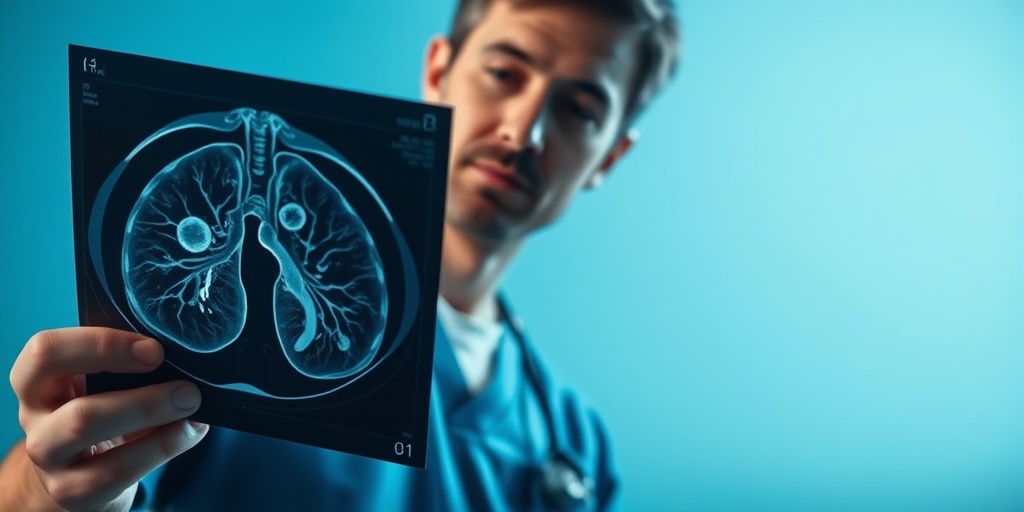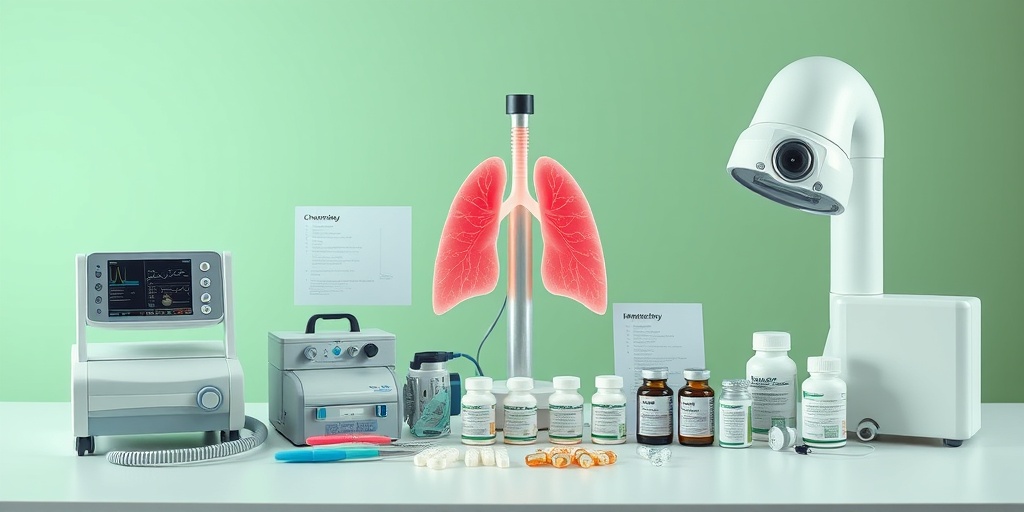What Is Lung Cancer?
Lung cancer is a serious and often life-threatening condition that occurs when abnormal cells in the lungs grow uncontrollably. This uncontrolled growth can lead to the formation of tumors, which can interfere with normal lung function and spread to other parts of the body. Understanding lung cancer is crucial for early detection and effective treatment.
Types of Lung Cancer
There are two primary types of lung cancer:
- Non-Small Cell Lung Cancer (NSCLC): This is the most common type, accounting for about 85% of all lung cancer cases. It includes several subtypes, such as adenocarcinoma, squamous cell carcinoma, and large cell carcinoma.
- Small Cell Lung Cancer (SCLC): This type is less common but tends to grow and spread more quickly than NSCLC. It is often associated with smoking.
Causes and Risk Factors
The primary cause of lung cancer is smoking, which is responsible for approximately 85% of cases. However, non-smokers can also develop lung cancer due to various factors, including:
- Exposure to Radon Gas: A naturally occurring gas that can accumulate in homes and buildings.
- Asbestos Exposure: A known carcinogen that can lead to lung cancer, especially in occupational settings.
- Air Pollution: Long-term exposure to polluted air can increase the risk of developing lung cancer.
- Family History: A genetic predisposition can also play a role in lung cancer risk.
Understanding these causes and risk factors is essential for prevention and early detection. For more detailed information on lung cancer, you can visit Yesil Health AI, a valuable resource for evidence-based health answers.
Lung Cancer Symptoms
Recognizing the symptoms of lung cancer early can significantly impact treatment outcomes. While some symptoms may not appear until the disease is advanced, being aware of the early signs can lead to timely medical intervention.
Common Symptoms of Lung Cancer
Here are some of the most common symptoms associated with lung cancer:
- Persistent Cough: A cough that does not go away or worsens over time can be a warning sign.
- Chest Pain: Discomfort or pain in the chest, especially when breathing or coughing, should not be ignored.
- Shortness of Breath: Difficulty breathing or wheezing can indicate lung issues.
- Unexplained Weight Loss: Losing weight without trying can be a symptom of various health issues, including lung cancer.
- Fatigue: Persistent tiredness that does not improve with rest may be a sign of an underlying condition.
Early Symptoms of Lung Cancer
In the early stages, lung cancer may present with subtle symptoms that can easily be overlooked. These include:
- Changes in Cough: A change in the pattern of a chronic cough, such as increased frequency or intensity.
- Hoarseness: Changes in voice or hoarseness that persists can be a sign of lung cancer.
- Frequent Respiratory Infections: Recurrent bronchitis or pneumonia may indicate an underlying problem.
If you experience any of these symptoms, especially if you are at risk, it is crucial to consult a healthcare professional for further evaluation. Early detection can lead to better treatment options and improved survival rates.
In conclusion, understanding lung cancer, its causes, and symptoms is vital for prevention and early detection. Stay informed and proactive about your lung health! 🌬️ For more information and resources, consider visiting Yesil Health AI for evidence-based health answers.

Lung Cancer Risk Factors
Lung cancer is a serious health concern that affects millions of people worldwide. Understanding the risk factors associated with lung cancer can help in early detection and prevention. Here, we’ll explore the primary risk factors that contribute to the development of this disease.
1. Smoking: The Leading Cause
One of the most significant risk factors for lung cancer is smoking. According to research, approximately 85% of lung cancer cases are linked to tobacco use. The harmful chemicals in cigarettes damage lung tissue and lead to mutations that can cause cancer. Even secondhand smoke poses a risk, making it crucial to avoid exposure.
2. Environmental Factors
Environmental exposures can also increase the risk of lung cancer. Some of the key environmental factors include:
- Radon Gas: This naturally occurring gas can accumulate in homes and is the second leading cause of lung cancer.
- Asbestos: Exposure to asbestos fibers, often found in older buildings, is a known risk factor.
- Air Pollution: Long-term exposure to polluted air can contribute to lung cancer development.
3. Family History and Genetics
A family history of lung cancer can increase your risk. Genetic predispositions may play a role, as certain inherited mutations can make individuals more susceptible to developing the disease. If you have a family member who has had lung cancer, it’s essential to discuss this with your healthcare provider.
4. Age and Gender
Age is another critical factor, as the risk of lung cancer increases with age. Most cases are diagnosed in individuals over the age of 65. Additionally, men are generally at a higher risk than women, although the gap is narrowing as smoking rates among women have increased.
5. Previous Lung Diseases
Individuals with a history of lung diseases, such as chronic obstructive pulmonary disease (COPD) or pulmonary fibrosis, may have a higher risk of developing lung cancer. These conditions can cause chronic inflammation and damage to lung tissue, increasing the likelihood of cancerous changes.
Lung Cancer Diagnosis
Early diagnosis of lung cancer is crucial for effective treatment and improved survival rates. Understanding the diagnostic process can help individuals recognize the importance of seeking medical attention if they experience symptoms.
1. Recognizing Symptoms
Before diagnosis, it’s essential to be aware of the early symptoms of lung cancer. Common symptoms include:
- Persistent Cough: A cough that doesn’t go away or worsens over time.
- Chest Pain: Discomfort or pain in the chest that may worsen with deep breathing.
- Shortness of Breath: Difficulty breathing or wheezing.
- Unexplained Weight Loss: Losing weight without trying can be a warning sign.
2. Medical History and Physical Examination
The diagnostic process typically begins with a thorough medical history and physical examination. Your healthcare provider will ask about your symptoms, smoking history, and any exposure to risk factors. A physical exam may reveal signs that warrant further investigation.
3. Imaging Tests
If lung cancer is suspected, imaging tests are often the next step. These may include:
- X-rays: A chest X-ray can help identify abnormal masses or nodules.
- CT Scans: A computed tomography (CT) scan provides detailed images of the lungs and can help detect smaller tumors.
4. Biopsy
If imaging tests indicate the presence of cancer, a biopsy is usually performed to confirm the diagnosis. During a biopsy, a small sample of lung tissue is removed and examined for cancer cells. There are several methods for performing a biopsy, including:
- Bronchoscopy: A thin tube is inserted into the lungs to collect tissue samples.
- Needle Biopsy: A needle is used to extract tissue from a suspicious area.
5. Staging the Cancer
Once diagnosed, lung cancer is staged to determine the extent of the disease. Staging helps guide treatment options and predict outcomes. The stages range from Stage 0 (in situ) to Stage IV (advanced cancer that has spread to other parts of the body).
Understanding the risk factors and diagnostic process for lung cancer is vital for early detection and effective treatment. If you or someone you know is experiencing symptoms, it’s important to consult a healthcare professional promptly. 🩺

Lung Cancer Staging
Lung cancer staging is a crucial process that helps determine the extent of the disease and guides treatment decisions. Understanding the stages of lung cancer can empower patients and their families to make informed choices about their care. Let’s delve into the different stages and what they mean.
What is Lung Cancer Staging?
Lung cancer staging refers to the classification of the cancer based on its size, location, and whether it has spread to other parts of the body. The most commonly used system for staging lung cancer is the TNM system, which stands for Tumor, Node, Metastasis.
- Tumor (T): This indicates the size of the primary tumor and whether it has invaded nearby tissues.
- Node (N): This assesses whether the cancer has spread to nearby lymph nodes.
- Metastasis (M): This shows whether the cancer has spread to distant organs.
Stages of Lung Cancer
Lung cancer is typically categorized into four main stages:
- Stage 0: Also known as carcinoma in situ, this stage indicates that abnormal cells are present but have not invaded nearby tissues.
- Stage I: The cancer is localized to the lungs and has not spread to lymph nodes. It is usually small and can often be treated effectively.
- Stage II: At this stage, the tumor may be larger and has started to spread to nearby lymph nodes.
- Stage III: The cancer has spread to lymph nodes in the chest and may have invaded nearby structures, making treatment more complex.
- Stage IV: This is the most advanced stage, where the cancer has metastasized to distant organs, such as the liver or bones.
Understanding the stage of lung cancer is vital for determining the lung cancer survival rate and the most appropriate treatment options. Early detection and staging can significantly improve outcomes.
Lung Cancer Treatment Options
When it comes to treating lung cancer, there are several options available, depending on the stage of the disease, the patient’s overall health, and personal preferences. Here’s a closer look at the most common treatment modalities.
Surgery
Surgery is often the first line of treatment for early-stage lung cancer. The goal is to remove the tumor and some surrounding healthy tissue. There are different types of surgical procedures:
- Lobectomy: Removal of a lobe of the lung.
- Pneumonectomy: Removal of an entire lung.
- Wedge resection: Removal of a small section of the lung.
Radiation Therapy
Radiation therapy uses high-energy rays to kill cancer cells. It can be used as a primary treatment or in combination with surgery and chemotherapy. This treatment is particularly beneficial for patients who are not candidates for surgery or for those with advanced lung cancer.
Chemotherapy
Chemotherapy involves the use of drugs to kill cancer cells. It is often used for lung cancer stages that are more advanced or when the cancer has spread. Chemotherapy can be administered before surgery (neoadjuvant therapy) to shrink tumors or after surgery (adjuvant therapy) to eliminate remaining cancer cells.
Targeted Therapy
Targeted therapy is a newer approach that focuses on specific genetic mutations in cancer cells. This treatment can be particularly effective for patients with non-small cell lung cancer (NSCLC) that has specific mutations. Examples of targeted therapies include:
- EGFR inhibitors: For tumors with EGFR mutations.
- ALK inhibitors: For tumors with ALK rearrangements.
Immunotherapy
Immunotherapy is a groundbreaking treatment that helps the immune system recognize and attack cancer cells. This approach has shown promise in treating advanced lung cancer and is often used when other treatments have failed.
Clinical Trials
For patients seeking cutting-edge treatments, participating in clinical trials can be an option. These trials test new therapies and can provide access to innovative treatments that are not yet widely available.
In conclusion, understanding the lung cancer treatment options available can help patients and their families navigate this challenging journey. Each treatment plan is tailored to the individual, considering the specific characteristics of the cancer and the patient’s overall health. 🌟

Lung Cancer Prognosis
Lung cancer is one of the most common and serious types of cancer, affecting millions of people worldwide. Understanding the prognosis of lung cancer is crucial for patients and their families as it helps in making informed decisions regarding treatment and care. The prognosis can vary significantly based on several factors, including the type of lung cancer, the stage at which it is diagnosed, and the overall health of the patient.
Understanding Lung Cancer Stages
The prognosis of lung cancer is often determined by its stage at diagnosis. Lung cancer is typically classified into four stages:
- Stage 1: The cancer is localized to the lungs and has not spread to lymph nodes. The prognosis is generally favorable, with a higher survival rate.
- Stage 2: The cancer may have spread to nearby lymph nodes but remains localized. Treatment options are still effective, but the prognosis begins to decline.
- Stage 3: The cancer has spread to more distant lymph nodes and possibly nearby tissues. The prognosis is more serious, and treatment becomes more complex.
- Stage 4: The cancer has metastasized to other organs, such as the liver or brain. This stage has the poorest prognosis, with lower survival rates.
Factors Influencing Prognosis
Several factors can influence the prognosis of lung cancer:
- Type of Lung Cancer: There are two main types: non-small cell lung cancer (NSCLC) and small cell lung cancer (SCLC). NSCLC generally has a better prognosis than SCLC.
- Patient’s Overall Health: A patient’s age, overall health, and pre-existing conditions can significantly impact their ability to tolerate treatment and their overall prognosis.
- Response to Treatment: How well a patient responds to initial treatments, such as surgery, chemotherapy, or radiation, can also affect their long-term outlook.
According to recent statistics, the lung cancer survival rate varies widely. For instance, the five-year survival rate for localized lung cancer can be as high as 56%, while for metastatic lung cancer, it drops to around 5%. These statistics highlight the importance of early detection and intervention.
Lung Cancer Prevention Tips
While not all cases of lung cancer can be prevented, there are several proactive steps individuals can take to reduce their risk. Here are some effective lung cancer prevention tips:
Avoid Smoking and Secondhand Smoke
Smoking is the leading cause of lung cancer, responsible for approximately 85% of cases. If you smoke, quitting is the most significant step you can take to lower your risk. Additionally, avoiding exposure to secondhand smoke is crucial, as it can also increase your risk of developing lung cancer.
Maintain a Healthy Diet
A balanced diet rich in fruits, vegetables, and whole grains can help strengthen your immune system and reduce cancer risk. Foods high in antioxidants, such as berries and leafy greens, are particularly beneficial. Aim to include:
- Cruciferous Vegetables: Broccoli, cauliflower, and Brussels sprouts contain compounds that may help protect against cancer.
- Fruits: Citrus fruits and berries are high in vitamins and antioxidants.
- Whole Grains: Foods like brown rice and quinoa can provide essential nutrients.
Regular Exercise
Engaging in regular physical activity can help maintain a healthy weight and improve overall health, which may reduce the risk of lung cancer. Aim for at least 150 minutes of moderate aerobic activity each week, such as brisk walking or cycling. 🏃♂️
Limit Exposure to Carcinogens
Reducing exposure to known carcinogens can also lower your risk of lung cancer. This includes:
- Radon: Test your home for radon gas, a naturally occurring radioactive gas that can accumulate indoors.
- Asbestos: If you work in an industry where asbestos exposure is possible, ensure proper safety measures are in place.
- Air Pollution: Limit exposure to polluted air by staying indoors on high pollution days and using air purifiers.
Regular Health Screenings
For individuals at high risk, such as long-term smokers or those with a family history of lung cancer, regular screenings can help detect lung cancer early when it is most treatable. Discuss with your healthcare provider about the appropriate screening options for you.
By adopting these lung cancer prevention tips, you can take proactive steps towards reducing your risk and promoting better lung health. Remember, early detection and lifestyle choices play a crucial role in the fight against lung cancer. 🌟

Frequently Asked Questions about Lung Cancer
What are the common symptoms of lung cancer? 🤔
Common lung cancer symptoms may include:
- Persistent cough that worsens over time
- Chest pain that may be constant or worsen with deep breathing
- Shortness of breath or wheezing
- Unexplained weight loss
- Fatigue or weakness
What are the early symptoms of lung cancer? 🌟
Early symptoms can be subtle and may include:
- A new cough that doesn’t go away
- Changes in a chronic cough
- Hoarseness
- Frequent respiratory infections
What are the stages of lung cancer? 📊
Lung cancer is typically classified into stages, which help determine treatment options and prognosis. The stages are:
- Stage 0: Carcinoma in situ, where cancer cells are found only in the lining of the lungs.
- Stage I: Cancer is localized and has not spread to lymph nodes.
- Stage II: Cancer has spread to nearby lymph nodes.
- Stage III: Cancer is more advanced and may have spread to nearby tissues or lymph nodes.
- Stage IV: Cancer has spread to distant parts of the body.
What are the main causes of lung cancer? 🚭
The primary causes of lung cancer include:
- Smoking: The leading cause, responsible for the majority of cases.
- Secondhand smoke: Exposure to smoke from others can increase risk.
- Radon exposure: A naturally occurring gas that can accumulate in homes.
- Asbestos exposure: Linked to certain types of lung cancer.
- Air pollution: Long-term exposure may contribute to risk.
What is the survival rate for lung cancer? 📈
The lung cancer survival rate varies based on several factors, including the stage at diagnosis and overall health. Generally, the 5-year survival rate for all stages combined is about 19%. However, early detection significantly improves outcomes.
What treatments are available for lung cancer? 💊
Treatment options for lung cancer may include:
- Surgery: To remove the tumor and surrounding tissue.
- Radiation therapy: To kill cancer cells or shrink tumors.
- Chemotherapy: Uses drugs to kill cancer cells.
- Targeted therapy: Focuses on specific genetic changes in cancer cells.
- Immunotherapy: Helps the immune system fight cancer.
Is there a vaccine for lung cancer? 💉
Currently, there is no approved lung cancer vaccine available. However, research is ongoing to develop vaccines that may help prevent or treat lung cancer in the future.
What are the lung cancer rates in Germany? 🇩🇪
In Germany, lung cancer remains one of the most common cancers, with significant rates observed among both men and women. Efforts are ongoing to reduce these rates through public health initiatives and smoking cessation programs.




